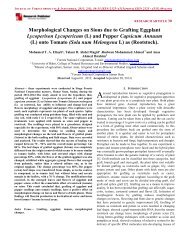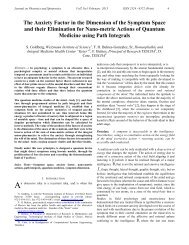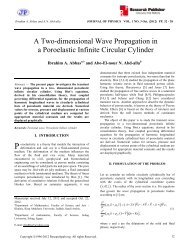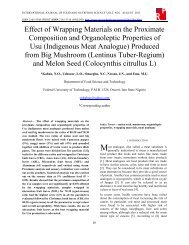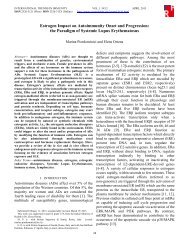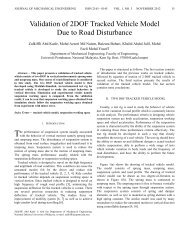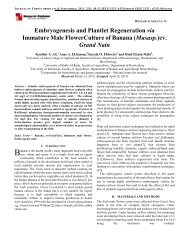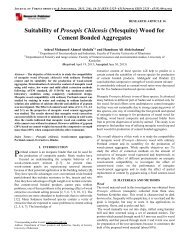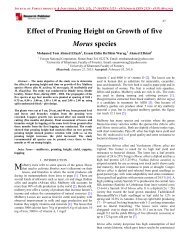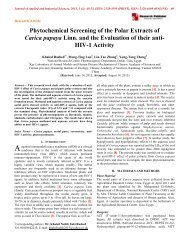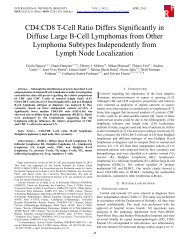Antiviral Activity and Phytochemical Analysis of Ailanthus Excelsa ...
Antiviral Activity and Phytochemical Analysis of Ailanthus Excelsa ...
Antiviral Activity and Phytochemical Analysis of Ailanthus Excelsa ...
Create successful ePaper yourself
Turn your PDF publications into a flip-book with our unique Google optimized e-Paper software.
JOURNAL OF FOREST PRODUCTS & INDUSTRIES, 2013, 2(3), 30-33 ISSN:2325–4513(PRINT) ISSN 2325 - 453X (ONLINE)33VI. CONCLUSION<strong>Ailanthus</strong> excelsa bark Chlor<strong>of</strong>orm extract can be as a promisingsource as antiviral agent <strong>and</strong> this is due to the presence <strong>of</strong> theinteresting bioactive phytoconstituents as quassinoids <strong>and</strong>alkaloids (canthin-6-one ) <strong>and</strong> it may be appropriate for furthertherapeutic studies against herpes viruses.Conflict <strong>of</strong> interestThere is no conflict <strong>of</strong> interest associated with the authors <strong>of</strong> thispaper.REFERENCES[1] Clark, A. M. (1996). Natural Products as a Resource for New Drugs.Pharmaceutical Research 13: 1133-1141.[2] Cragg, G. M. <strong>and</strong> Newman, D. J. (2005). Plants as a source <strong>of</strong> anticanceragents. Journal <strong>of</strong> Ethanopharmacology 100: 72-79.[3] Shrimali, M., Jain, D. C., Darokar, M. P., Sharma, R. P. (2001).Antibacterial activity <strong>of</strong> <strong>Ailanthus</strong> excelsa (Roxb.). Phytotherapy Research15:165-166.[4] Joshi, B. C., P<strong>and</strong>ey, A., Sharma, R. P, Khare, A. (2003b). Quassinoidsfrom <strong>Ailanthus</strong> excelsa Phytochemistry 62: 579-584.[5] Dhanasekaran, S., Suresh, B., Sethuraman, M., Rajan, S. <strong>and</strong> Dubey, R.,(1993). Antifertility activity <strong>of</strong> <strong>Ailanthus</strong> excelsa Linn in female albino rats.Indian Journal <strong>of</strong> Experimental Biology 31:384-391.[6] Ogura, M., Cordell, G. A., Kinghorn, A. D., Farnsworth, N. R. (1977).Potential anticancer agents VI. Constituents <strong>of</strong> <strong>Ailanthus</strong> excelsa(Simaroubaceae). Lioydia 40: 579-584.[7] Asolkar, L. V., Kakkar, K. K., Chakre O. J. (1992) “ Glossary <strong>of</strong> IndianMedicinal Plants with Active Principles ” , C.S.I.R., New Delhi, Part-I, pp. 34-58.[8] Cordell GA, Ogura M, Farnsworth NR. (1978). Alkaloids constituents <strong>of</strong><strong>Ailanthus</strong> excelsa. Lioydia 41, 166- 168.[9] Said A., Rashed K., Tokuda H., Huefner A.(2012). Antitumor activity <strong>of</strong><strong>Ailanthus</strong> excelsa Roxb. stem bark fractions <strong>and</strong> <strong>of</strong> canthin-6-one. IUFSJournal <strong>of</strong> Biology 71(1): 112-121.[10] Nag A, Matai S. (1994). <strong>Ailanthus</strong> excelsa Roxb. (Simaroubaceae), apromising source <strong>of</strong> leaf protein. Journal <strong>of</strong> Agriculture <strong>and</strong> Food Chemistry,35: 1115-1117.[11] Khan, S. A, Shamsuddin, K. M. (1980). Glaucarubol from <strong>Ailanthus</strong>excelsa. Phytochemistry 19:2484-2485.[12] Joshi, BC., Pendey, A, Chaurasia L., Pal M., Sharma R. P., Khare A.(2003a). Antifungal activity <strong>of</strong> the stem bark <strong>of</strong> <strong>Ailanthus</strong> excelsa.Fitotherpia 74:689-691.[13] Said A, Tundis R, Hawas WU, El-Kousy S, Rashed K, Menichini F,Bonesi M, Huefner A, Monica RL, Menichini F. (2010). In vitro Antioxidant<strong>and</strong> antiproliferative activities <strong>of</strong> flavonoids from <strong>Ailanthus</strong> excelsa (Roxb)(Simaroubaceae) leaves. Z. Naturforsch, 65c, 180-186.[14] Connolly J. D, Overton K. H, Polonsky J. (1970). The chemistry <strong>and</strong>biochemistry <strong>of</strong> the linonoids <strong>and</strong> quassinoids. In: Reinhold l, Liwashitz Y(eds) Progress in phytochemistry. Wiley, London, pp 385-412.[15] Wolf, H. H, Swinyard E. A, Goodman L. S. (1962). Anticonvulsantproperties <strong>of</strong> some N-substituted hydanoins. J Phrama Sci 51:74-76.[16] Harbone, J. B. (1973). <strong>Phytochemical</strong> methods. Chapman & Hall,London, pp.40-107.[17] Farnsworth, N. R (1966). Biological <strong>and</strong> phytochemical screening <strong>of</strong>plants. Journal <strong>of</strong> Pharmceutical Sciences 55, 225-276.[18] Geissman, T.A. (1962). The Chemistry <strong>of</strong> flavonoids compounds.Pergamon, London, pp.126-147.[19] Arisawa, M., Hayashi K, Nikaido T, Koike K, Fujita D, Nunomura N,Tanaka, M, Sasaki T. (1997). International J. <strong>of</strong> Pharmacology 35 (1):6-14.[20] Husing, G. D, Melnick J. L. (1957). Morphologic characteristics <strong>of</strong>plaques produced on monkey kidney monolayer cultures by enteric viruses(poliomyelitis, Coxsackie, <strong>and</strong> echo groups. Journal <strong>of</strong> Immunology78:128-135.[21] Ren Z, Zhang C. H, Wang L. J, Cui Y. X, Qi R. B, Yang C. R, Zhang Y.J, Wei X.Y, Lu D. X, Wang Y. F. (2010). In vitro anti-viral activity <strong>of</strong> thetotal alkaloids from Tripterygium hypoglaucum against herpes simplex virustype 1. Virologica sinica 25:107-114.[22] IIkay O, Berrin Ozcelik, Taner K, Bilge S. (2007). <strong>Antiviral</strong> activity <strong>of</strong>alkaloids isolated from Fumaria <strong>and</strong> Corydalis species. Z. Naturforsch, 62c,19-26.[23] Nugraha, A.S, Keller P.A. (2011). Revealing indigenous Indonesiantraditional medicine: anti-infective agents. Natural Product Communications6 (12):1953-1966.



